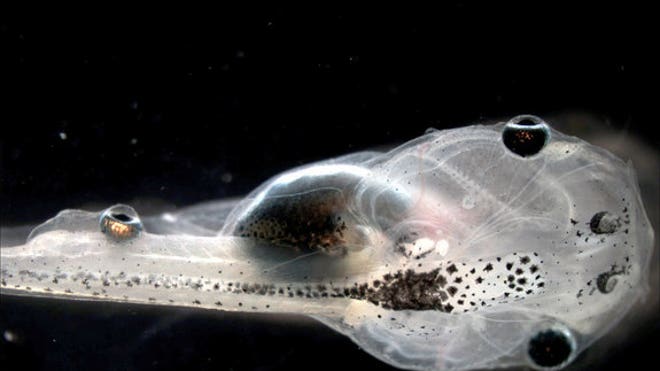Summary:
Levin and Douglas Blackiston from Tufts University in Medford, Massachusetts wanted to know
whether the brain gets visual information only from eyes in the
head or if the brain could receive data coming from other places. To find out, they started with African clawed frog tadpoles and removed the
normal eyes. They then transplanted cells that would grow into eyes onto the
animals’ tails.
 The Tufts team put
the tadpoles with transplanted eyes in chambers in which half was lit up with blue light and the other half with red light. They zapped the tadpoles with electric
shock when it was in one half of the chamber so that the animal
learned to associate the color with the shock.
The Tufts team put
the tadpoles with transplanted eyes in chambers in which half was lit up with blue light and the other half with red light. They zapped the tadpoles with electric
shock when it was in one half of the chamber so that the animal
learned to associate the color with the shock.
Eventually, Levin and Douglas found that tadpoles that had tail eyes had grown nerves to connect to the spinal column were able to learn
the color-shock association and swim away from the light in which they were shocked in. Tadpoles whose tail eyes had connected to the stomach or some other part
of the body did not learn the association. Neither did tadpoles with no eyes at all.
The finding suggests that visual information from the eye travels up the spinal
cord to the brain, which came as a surprise to the researchers because previous research had suggested eyes had to be directly connected to the brain to transmit visual information, but somehow the brains of those tadpoles with eyes on their tails were able to distinguish the color messages from other data traveling through the spinal cord.
The good thing about this research is that Levin and Blackiston’s
findings could help scientists better understand how the brain and body
communicate, including in humans, and could be important for regenerative
medicine or designing prosthetic devices to replace missing body parts such as the eye. 
NOS Themes:
- Role of Chance: The researchers had transplanted frog eyes to other body parts for decades, but until now, none had those oddly placed eyes actually to work.
- Science is Subject to Debate and Tentative: Previous research had suggested eyes needed to be directly connected to the brain to transmit visual information, but in the Tufts team’s results, it showed that visual information can travel up the spinal cord to the brain.
- Role of Skepticism: The researchers never really had their experiments work efficiently so the results may be of question as they said themselves with surprise.
Article Link:
http://www.sciencenews.org/view/generic/id/348633/description/Tadpoles_with_eyes_in_their_tails_see_the_light
Related Links:
- http://www.chem-tox.com/malathion/research/frog.htm
- http://www.biologynews.net/archives/2005/08/14/tadpole_soon_to_help_in_the_fight_against_cancer_and_lymphedema.html
- http://www.biologynews.net/archives/2008/11/03/redeyed_treefrog_embryos_actively_avoid_asphyxiation_inside_their_eggs.html
I once read about a baby who was trained to fear mice because every time a mouse came by a loud bang was played psychologists. What in the brain and nervous system do you think causes that?
ReplyDelete